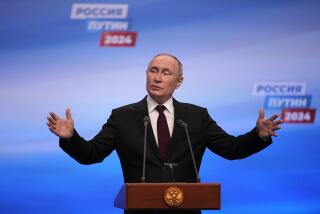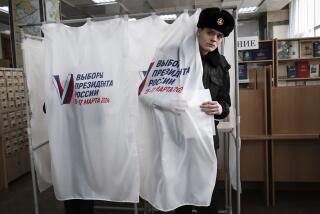Yeltsin Candidate Rejected for Russia Post : Republic: The vote for prime minister showed that the president still does not have full political support.
- Share via
MOSCOW — A moderate reformer was elected the prime minister of the Soviet Union’s Russian Republic on Friday after a radical proposed by Boris N. Yeltsin, the republic’s populist president, was rejected.
Ivan S. Silayev, 60, a Soviet deputy chairman in charge of the country’s machine-tool and engineering industry, was elected with 163 votes from among the 239 deputies of the Russian Supreme Soviet, the republic’s legislature, after Yeltsin withdrew his support from his own nominee in favor of Silayev.
The compromise illustrated the country’s fragile political balance that so far has kept radicals and conservatives in check, but also prevented bolder initiatives.
It again demonstrated that Yeltsin, despite his immense popularity, still does not command full and immediate political support in the body that elected him president of Russia, and that to be effective he will need to make deals with many he considers his foes.
And it left unclear the fate of Yeltsin’s economic program--a 500-day plan to privatize much of the Soviet economy, to close thousands of unprofitable enterprises, to shift millions of workers to other jobs and to force the pace of the country’s economic transformation, all without lowering living standards.
Silayev, who was portrayed as a conservative apparatchik during the debate before the vote, immediately declared his intention to accelerate the economic reforms in Russia, the largest of the Soviet Union’s constituent republics, and pledged to work closely with Yeltsin.
Declaring that they had “a good psychological rapprochement,” Silayev said that he and Yeltsin worked together for more than 15 years and see many of the country’s problems the same way.
“I will prove to you that I am not a conservative and do my utmost to implement radical reforms,” he said after his election. “All realistic ideas that can be achieved to resolve our many problems will be supported, and then Russia can be as it should in our Soviet Union.”
Giving himself a maximum of two years to reverse the deepening economic crisis but warning that a real solution would take much longer, Silayev said that his first priority would be to break down the old industrial system, one that he has helped to run for his whole career, that still operates on the basis of commands from the bureaucracy rather than the give-and-take of the marketplace.
“This is a very important event,” he said. “It means I have to draw the curtain on my past methods, principles and views and devote myself completely to the welfare of Mother Russia.”
Referring to Yeltsin’s ambitious program of privatization, spending cuts and deregulation within 500 days, Silayev told reporters: “Five hundred days is, after all, a year and a half. And in a year and a half, we have an obligation to act so that Russians feel that something positive has happened.”
Silayev, a mechanical engineer, was backed by the Communist Party’s national leadership, but he failed to win the required majority in the first round of voting against Mikhail Bocharov, 49, an outspoken lawyer and the manager of Moscow’s construction materials company. The vote was 119 to 86 with a number of abstentions that left Silayev a single vote short of the 120 he needed to win.
Bocharov has been one of Yeltsin’s key supporters, as well as a leader in the opposition Inter-Regional Group of Deputies and the radical Democratic Russia movement, and he had outlined Yeltsin’s 500-day plan for the Russian economy, which is the major component of the whole Soviet economy.
But after Bocharov came in a poor second in this first round of voting, Yeltsin called a 15-minute recess, conferred with Silayev, Bocharov and others and, when debate resumed, announced his support for Silayev.
A second vote was promptly held, and Silayev was elected without competition--but with nearly a third of the deputies still unreconciled to him and whatever deal Yeltsin had made and voting against him, as permitted on Soviet ballots.
A third candidate, Yuri Ryzhov, 60, the rector of the Moscow Aviation Institute and a political liberal, had withdrawn earlier.
Yeltsin, an outspoken critic of President Mikhail S. Gorbachev, was elected president of Russia three weeks ago, pledging radical measures to shift power from the central Soviet government to Russia. He is also fighting central government plans for the doubling of food prices and sharp increases in other consumer prices by the start of 1991.
Under Yeltsin’s own economic plan, Russia’s government would end subsidies to unprofitable enterprises after a 100-day preparation period. The plan also calls for large reductions in heavy industry and in mining, though that could leave millions unemployed.
Bocharov said the changes could occur with minimal harm to living standards, and he promised that those put out of work would be retrained while the government paid their salaries.
He also called for indexing to peg wages and pensions to price increases and soften the blow of inflation.
As outlined by Bocharov, the Yeltsin plan is divided into four phases--preparation, privatization, introduction of a market and stabilization.
In the first phase, expected to last 100 days, the government would refine and publicize the plan and warn enterprises about the upcoming end to subsidies. It would also conduct inventories of Russia’s resources and defense industry.
In the second phase, to last five months, a massive program of privatization of government-owned industry would be carried out. Bocharov said up to $320 billion, at present rates, would be raised by the selloff, though he did not specify how prices would be set or the money used.
Enterprises not sold would be required to begin leasing their premises and equipment from the government, rather than paying a fixed percentage of profit to the state budget as under the present system.
In the next five months, a market economy would be developed. Price controls would be lifted for the most part. Production in heavy industry would be allowed to go into a deep decline.
In the final 100 days, a stabilization phase, there would be large-scale government investment to resolve structural problems and a lowering of consumer prices through use of accumulated reserves.
More to Read
Sign up for Essential California
The most important California stories and recommendations in your inbox every morning.
You may occasionally receive promotional content from the Los Angeles Times.













